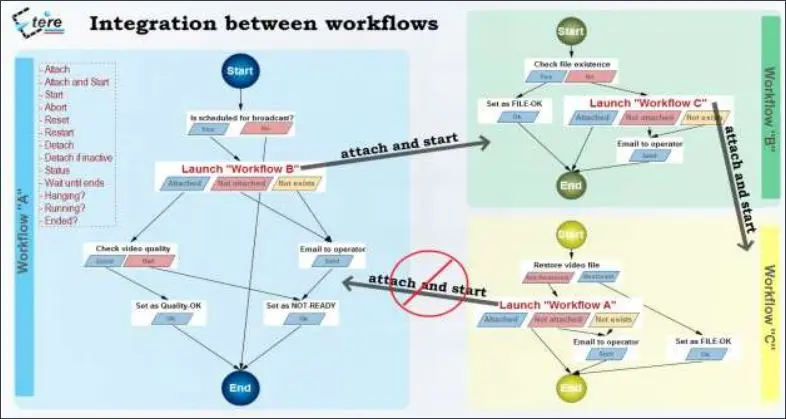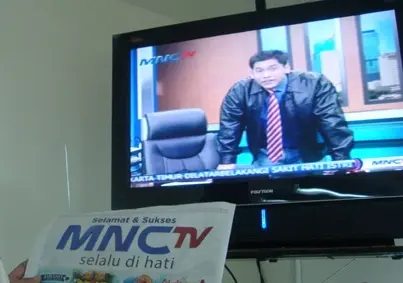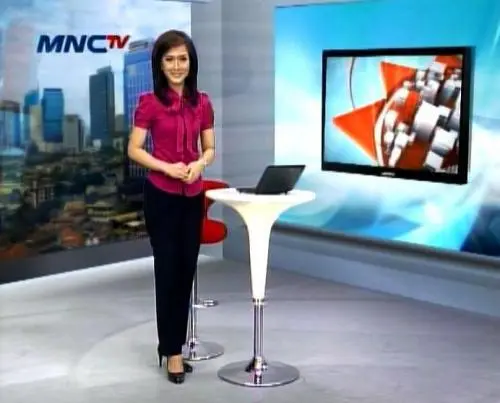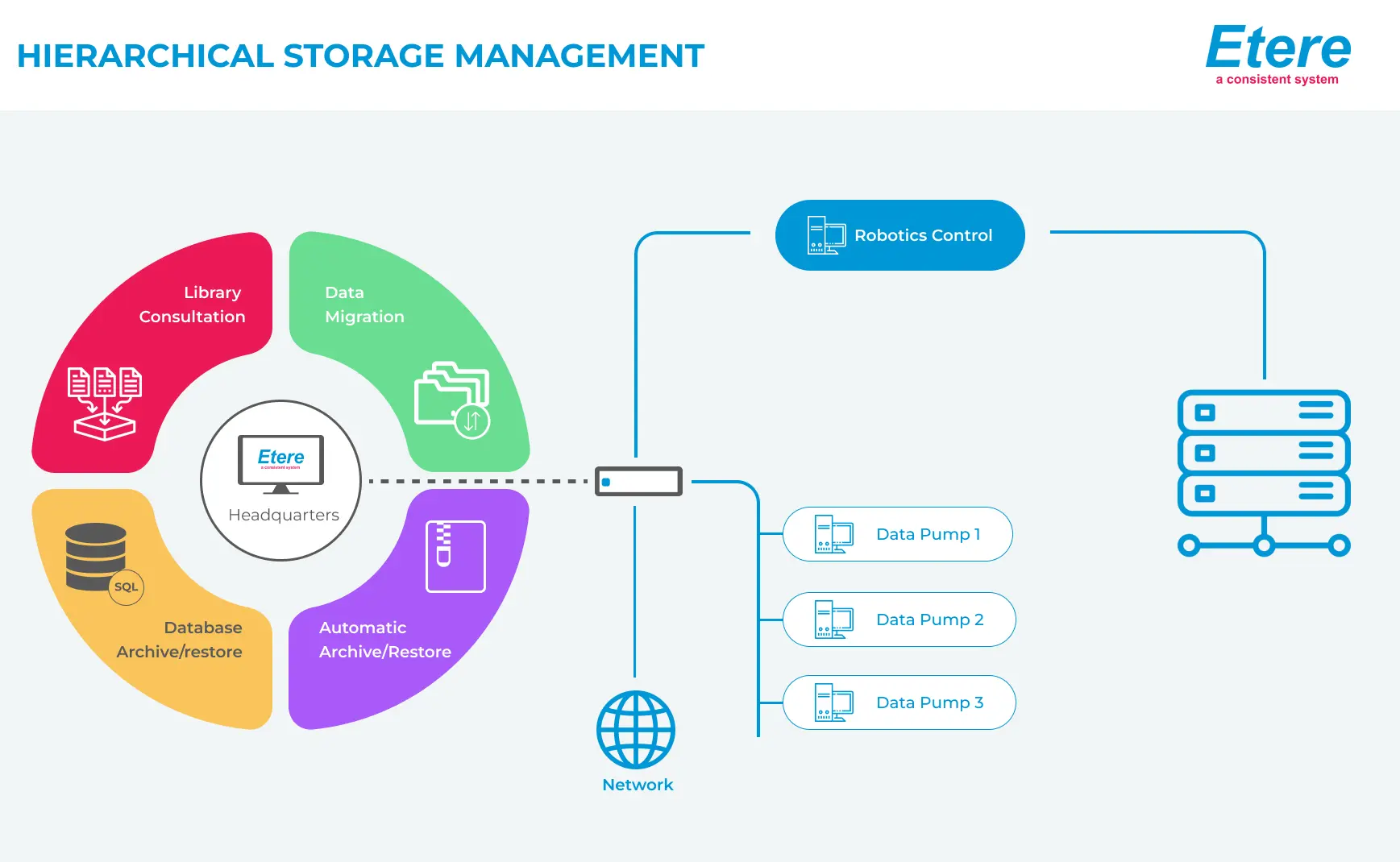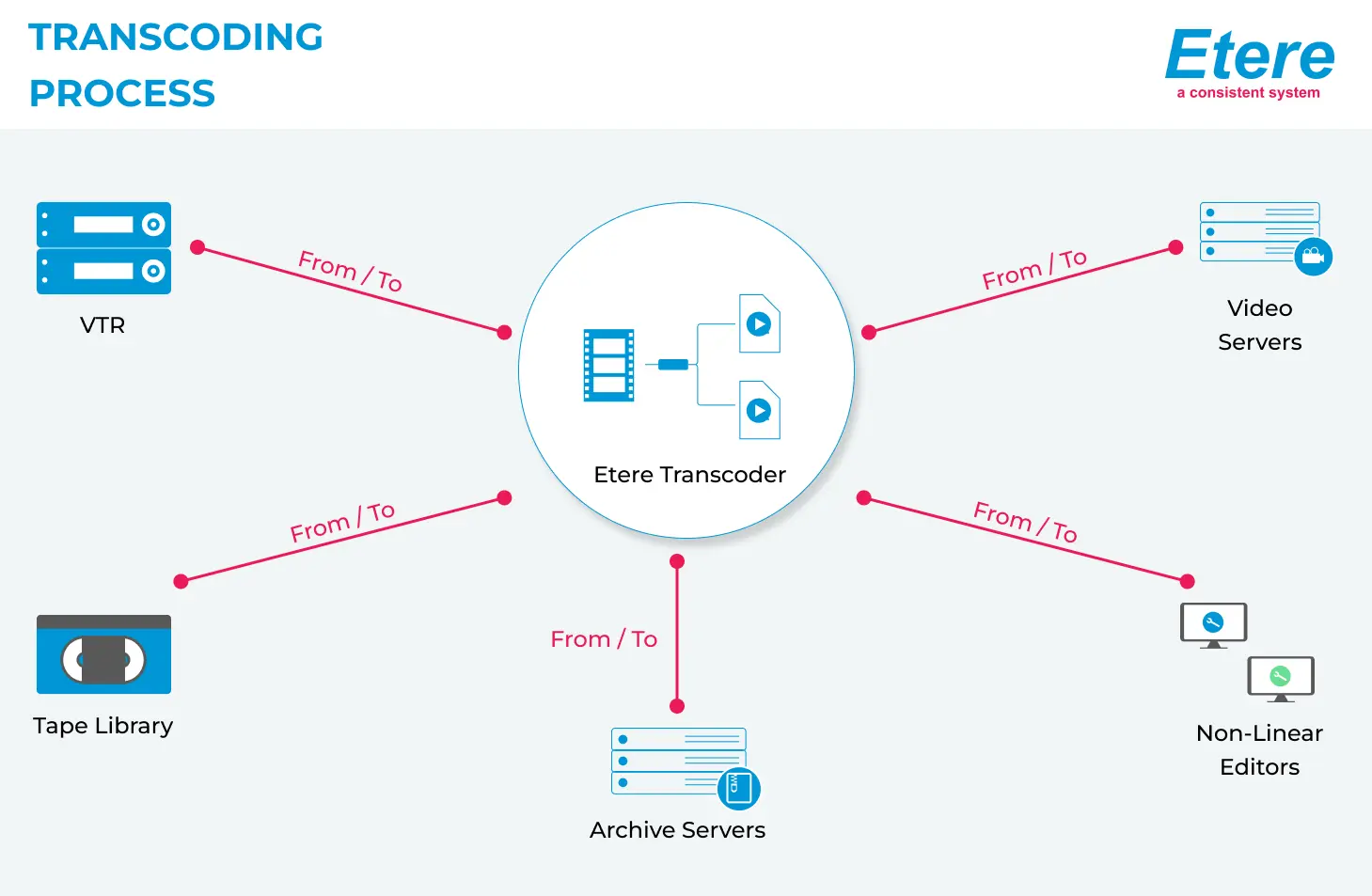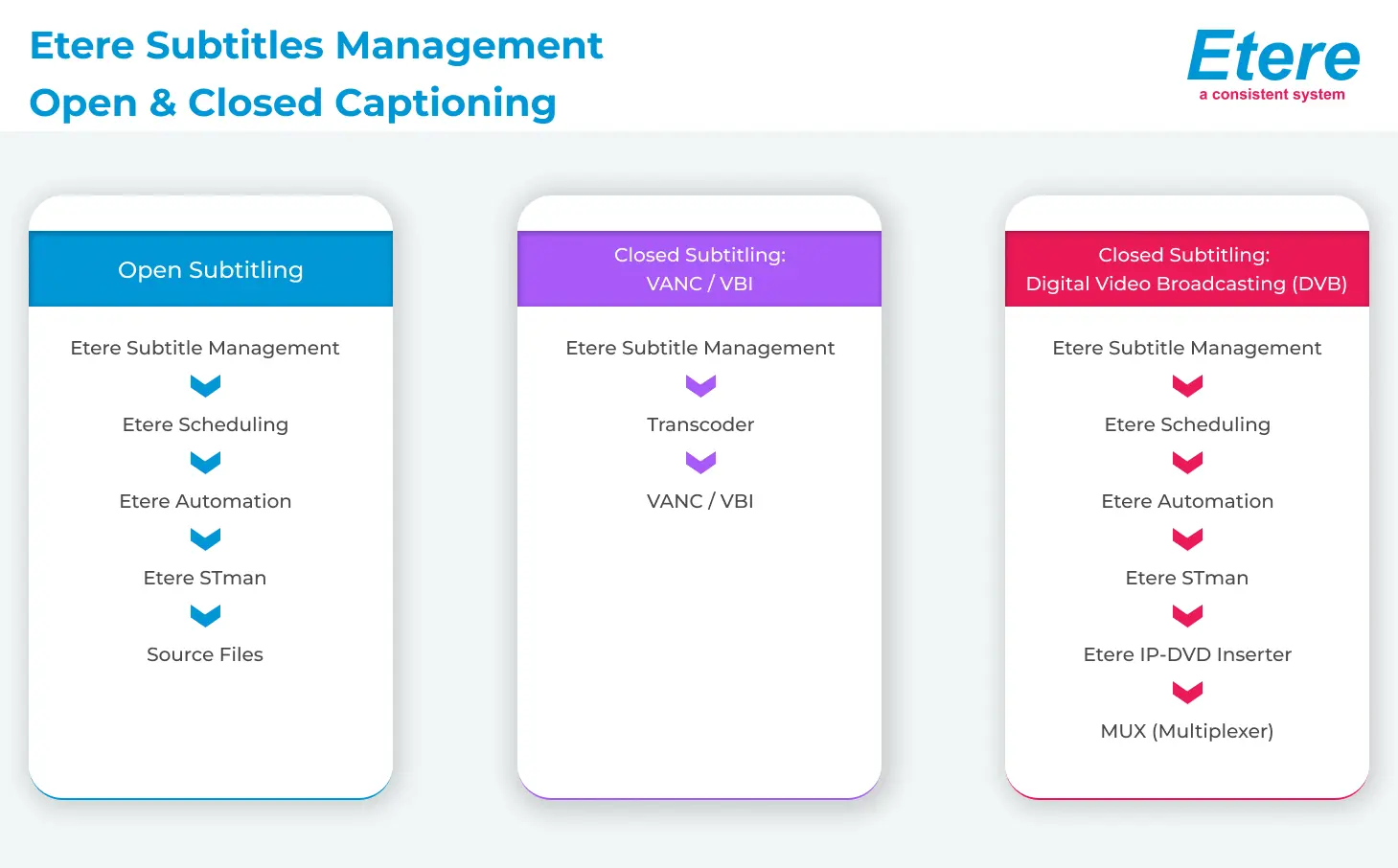MNC - Media Nusantara Citra
30 January 2013Global Media Asset Management for a multimedia group.
Media Nusantara Citra (MNC) is the largest Indonesian media company, founded in 1997 and currently owned 70% by PT Global Mediacom TBK Group. MNC’s significant content library is the largest in Indonesia, comprising entertainment and news content collected – with an increasing rate of more than 10,000 hours per year- from in-house produced content (movies, series, realities, comedies and TV films), third-party acquired content and multi- platform generated content. Etere system for MNC also interfaces Quantum tape library.
In order to consolidate its position as the major media company in Indonesia, MNC, has requested Etere a centralized and comprehensive digital archiving system, which will be used to convert and manage MNC digital content before a multi-platform content distribution which includes nationwide television networks, television program channels, newspaper, tabloids, and radio network.
This paper illustrates how the Etere’s proposed solution is aware about the importance of media archiving, and how it offers not only a world-acknowledged system but a hard-earned expertise on the implementation and maintenance of digital archives able to bring access to any file, at any time and most important, with a the maximum of speed, characteristics that will ensure the improvement of each single broadcasting area with a wide set of management and delivery applications.
Customer Request
The MNC engineering division has requested, as an essential deliverable requirement a centralized, comprehensive and web-enabled Digital Archiving Management System (DAMS) able to manage and convert MNC’s digital content. Moreover, the customer has also declared the following optional areas of interests that must be satisfied by the proposed system.
Etere Proposal
Etere, a worldwide leader in broadcasting and media solution, will provide MNC with an archive and distribution system able to manage all contents under a file-based environment, where content will be catalogued including all related metadata, facilitating the search and query of video contents through a comprehensive browsing application and providing the following key features:
■ A distributed architecture managed via workflow to avoid any single point of failure
■ Enterprise management of digital content under a file-based workflow environment
■ Seamless integration with existing and co-existing systems
■ Fast, safe and fully-tracked local/remote access to the content archive
■ Direct and efficient access for Editing Systems to the digital archive
■ Enterprise management and transport of media between storage devices
■ Transparent media transferring, the correct media format will be always delivered
■ Quality control to ensure the reliability of archived assets over short and long terms
■ High preservation and high availability of archived and catalogued media content
■ Browsing features including preview, slow-motion, timecode, bookmarking and metadata
■ Robust editing functions including video cut, merge, overlay and restore
■ Best flexibility on digitizing media content from multiple sources
■ Full integration support for NLE systems including content uploading/downloading
■ Reliable monitoring of the modules and equipment integrated within the global system
Etere will implement a “Digital Archiving Management System” able to capture, store and transparently manage the facilities archived material over the long term, this system will be a distributed solution which combines rock-solid reliability and high availability with increased bandwidth and storage, allowing operators to easily search, retrieve and browse any media they want from the digital archive. The station will be mainly provided with the following key features.
The features requested by the customer are following listed explaining how Etere is able to accomplish them with the maximum of reliability:
3.1 Efficient Capture/Ingest system
Etere will provided MNC with Etere Ingest (see chapter 6.1), the flexible solution for capturing content from a wide range of sources including tapeless cameras (P2, XDCAM, DVCPRO, HD Ready, etc.) and video cassettes (BetaCam, Mini DV, DVCAM, etc.) as well as satellite feeds, multi-format file-based and IP-based video streaming.
3.2 Ingest Management System
As mentioned before, Etere Ingest (see chapter 6.1) is the module that will takes care of capturing content, covering any particular requirement of the entire process such as automatic and scheduled ingests, supporting also multiple parallel ingest streams managed automatically either on a single workstation or across various workstations. Etere Ingest counts with a reliable failover system which permits to manage different sets of recording resources ready to be switched in case of error or maintenance, providing also a dedicated logging module for detailed information on each single operation performed while capturing content.
3.3 Metadata
MNC will be provided with Etere MAM (see chapter 6.2), the best solution for indexing and enriching media content through a comprehensive, fast and robust environment for searching, browsing and cataloguing media with custom metadata (either user-defined or SMPTE). Etere MAM, thanks to a very intuitive interface establishes a bridge between the ingest department and the production department, allowing contents to be browsed simultaneously from various workstations thus enabling low-res proxy browsing over the network (with further import/export functions from and to other systems respectively).
3.4 Central Storage
The central storage will be managed following the basis of an enterprise video file system (i.e. ability to play major file formats, compatibility with editing systems, SD/HD conversion capabilities, etc.).
Etere Media Manager (see chapter 6.3) will guarantee – besides a workflow-based media management- also timing and effectiveness on media transfers between devices, offering high performances and availability under an expandable and scalable context.
Etere HSM (see chapter 6.4) will allow MNC to have an automatic and tape-based storage system for long-term management archiving (supporting LTO1-2-3-4-5, DLT, DTF, etc.). Etere HSM will improve the management of libraries inside the station by controlling their mechanical movements through the HSM Robotics Control and HSM Data Pump applications, which are able to run several data pumps on different machines to boost their throughput, while offering access to real-time logs, reports and statistics.
EtereWeb (see chapter 6.5), provides a secure and robust threshold to the station’s outside world, featuring a web-based interface to permit a tight integration with NLE systems and remote facilities.
3.5 Integration with Master Control (MCR) video server and automation
Etere will provide MNC with a seamless integration of all critical components with the station’s existing automation systems (Harris and Pebble Beach systems). An Etere Digital Archiving Management System will be designed to be agnostic of non-Etere playout servers, it will “simply” make all required content available at the right place, in the right time and -last but not least- in the right format thanks to the media management module Etere Media Management (see chapter 6.3).
3.6 Open and Scalable System
Due to its fully distributed architecture, Etere is able to provide an open and scalable system ready to be tightly integrated with current future new elements without changing the overall station workflow, thus making possible a smooth upgrade of MNC’s MAM system. Etere BMS (see chapter 6.6) is the right solution for distributing contents across different platforms (e.g. Digital Mobile TV, HD TV, IP TV, News media), this, due a professional rights management of licensed assets which includes the definition of purchasing contracts where a supplier gives to the station the right of transmitting copyrighted media assets (e.g.: TV series, movies, etc.) in return to an agreed payment (i.e.: prepaid or at the use) under specific conditions (e.g.: platforms, dates, etc.).
3.7 Technical requirement
As will be explained in detail in the “Etere Architecture” section (chapter 4), Etere is a system based on a distributed architecture with no single point of failure on its core system. Etere modules can run independently (and redundantly) on different workstations interconnected via a local area network. All system configuration parameters, security roles, user data, and pre-defined rules are stored in a reliable SQL database supporting backup and redundancy operations.
4.ETERE ARCHITECTURE
Etere is based on a distributed architecture which allows different modules to run on different workstations interconnected via a local area network. All system configuration parameters, security roles, user data, and pre-defined rules are stored in a reliable SQL database supporting backup and redundancy operations.
4.1 Distributed System
ETERE is a distributed, modular and fully integrated broadcasting system composed by a set of applications specifically oriented to efficiently perform each complex phase of the broadcasting chain synchronously within the same database environment, being all managed by suitable user-defined workflows that ensure an efficient overall system controlling.
Etere’s distributed architecture allows achieving a top-level availability of resources and reliability of operations across the entire broadcast workflow thanks to its redundant capabilities to improve the fault resilience on any hardware or software failure.
4.2 Multi-level Storage Hierarchy
Etere systems improves the media management by introducing a multi-level storage management consisting in the use of different storage levels based on the frequency of use of the files stored on them. For example, data files which are frequently used will be stored on video servers (i.e. online servers) whereas those which are not used for a certain period of time (e.g. typically a few months) will be eventually archived in tapes (or any other long-term storage mean) and then automatically restored -to video servers- every time they are required by the broadcast playlist.
Etere offers a hierarchical storage management of media content, it allows to organize in user-specific levels an unlimited number of content versions with different access times (e.g. video servers, near-line servers, archive servers), being all these levels available to the operator under a simple and user-friendly interface:
Moreover, media holders (i.e. asset forms) can be organized –along with their related information-under a hierarchical structure based on Parent-Children relationships, thus allowing, for example, handling different versions of a same asset and all the assets derived from them:
4.3 User Access Levels
Etere provides stations with a ‘Rights Management Tool’ to control and track access to its various modules and functions, with it, stations will be able to freely assign (grant or deny) access to specific user groups (i.e. roles to which one or more users belongs to), thus allowing to set different mixtures of access levels for each group.
Etere allows managing different –and fully customizable- access levels for users which form part of the system, with Etere; it will be possible to configure specific access rights not only for different users, but also for different stations.
4.4 Rights-based Operations
All the functions provided by an Etere system (e.g. quality control, event scheduling, program playback, etc.) falls under different categories according to their nature (e.g. media manager, air sales, automation), the availability of these functions is determined by the ‘Right Management Tool’.
Thanks to this tool, stations will be allowed to reflect into the Etere system the actual way in which rights are managed within the station facility.
For example, scheduling operators will be allowed to use only those modules to which they are authorized to use, including (or excluding) some sensitive functions intended to be managed by system administrators.
5. ETERE MEDIA FUNCTIONALITIES
Etere’s solution features an integrated and professional approach based on a workflow management to optimize the station’s entire broadcasting system, reduce operating costs and facilitate overall process control. Etere Workflow permits modules to for example, seek confirmation for sensitive process, follow specific rules, enhance the efficiency and reliability of process, and manage multiple workflows to perform different tasks simultaneously and independently.
5.1 Multiple Storage Management
Etere reduce the complexity of managing storage devices by arranging physical storage devices present across the system into metadevices (logical devices), the use of metadevices improve the overall media management by offering the following features:
■ Automated management via workflow of logical devices including arching, restoring, transcoding, etc.,
■ Monitored storage space owing to the set of restrictions,
■ Increased storage and better performance since metadevices acts as a virtual device representing several logical disks or disk systems:
■ Distributed storage according to specific requirements without the need of creating partitions, just associate individual disk volumes to different
5.2 Custom Design Workflow
All workflows can be customized to fit the real needs of the station and thus give complete control
over the overall system management which offers:
■ Clear definition of each complex step of the broadcasting process,
■ Visual representation of each step mapped out on a PC not in a paper document,
■ Set of instructions and authorizations that must be followed in order to move forward,
■ Complete log of all steps carried out, operations denied etc.
A comprehensive and user-friendly workspace allows creating suitable workflows based on custom actions just by dragging and dropping the necessary elements into it:
5.3 Integration between workflows
Etere allows calling workflows from others just by inserting an action that can perform a specific task (i.e.: attach, attach and start, start, abort, reset, restart, detach, etc.) on a certain workflow:
The diagram below illustrates how Etere maintains the system consistency by avoiding loops between workflows (a message is displayed indicating action incompatibilities between workflows):
As shown above, for example, if 'workflow A' calls 'workflow B' and the 'workflow B' calls 'workflow C', the 'workflow C' will not be able to call the 'Workflow A'.
5.4 Workflow File-based Processing
Etere provides a wide range of templates for creating workflow actions regarding the most common file-based media operations, allowing to customize them and also use completely user-defined actions:
5.4.1 Content Check
Etere Content Check is an integrated file-based module for performing Quality Controls (QC) via workflow; it automatically detects and marks audio/video issues (e.g. freeze frames, black frames, scene changes, audio loss) on assets' EDL according to their quality, setting also a default quality rating at the end of the process.
Etere counts with a “content check” workflow action ready to be attached to an asset to analyze its proxy file searching for audio/video issues and mark them into the asset’s EDL list:
5.4.2 Quality Check
An Etere quality check workflow is able to automatically ask operators to assign a quality value to a certain asset(s) after browsing its video content:
5.4.3 Archiving
Etere allows you to design a workflow for archiving your assets on LTO tapes, including a quality and content check, a proxy copy generation and a final email indicating the result of the process:
5.4.4 Restore
Create a workflow to automatically restore any scheduled asset for its playout by searching for them amongst a group of devices arranged on basis of their priority:
5.4.5 Transcoding
Etere’s integration with Rhozet's Carbon Coder software handles a wide array of critical operations including format conversions, workflow operations that can be launched for example, immediately after a content capture:
5.4.6 Checksum MD5 Verification
Etere offers an enterprise control of video files integrity; it keeps a log of the hash md5 of video files such in a way that it is possible to verify at any time if they have been modified after their approval. All video files registered on the Etere’s database can be verified through an md5 checksum, this control is performed via workflow, each time that a video file is moved from one device to another, its initial hash md5 is calculated to allow a future checking:
The workflow editor allows creating custom Checksum workflows to either generate or check the MD5 hash of a video file.
5.4.7 Video Cut
Etere offers ‘Cut actions’ that permits to take only a portion of a certain video file, using a given time code SOM and EOM. Defining and using a Memory Cut operation is as easy as shown below:
5.4.8 Loudness Normalization
Etere provides a file-based loudness control, allowing stations not only to check the loudness level of media contents but also to normalize them to meet specific limitations.
As shown in the sample workflow above, “loudness normalization” workflows can be launched automatically for specific assets, for example, after their ingestion or tapeless reception (i.e. web upload).
5.4.9 Antivirus Scan
Etere includes, as a part of its enterprise media management, the capability of integrating antivirus protection within workflows, allowing stations to improve their media workflows (e.g.: post-upload workflows) by giving them the capability of automatically scanning transferred files for virus and thus end their work with a flourish.
As shown in the figure above, the automatic virus scan capability can be easily integrated within any workflow at any stage just by inserting an action block configured to perform the virus checking; stations can insert them, for example, within the default workflow to be launched after an EtereWeb upload.
5.5 Work Orders Management
Etere’s Work Order Management is the flexible solution that permits to virtually manage all operations actually involved in the media asset management, such as for example, subtitles generation, promo creation, tape copying, media editing, audio dubbing, etc. Etere integrates the management of work orders, from their creation and compilation to their tracking and invoicing:
Work orders are based on a custom structure and are fully integrated into the workflow management, being possible to create user-defined work orders and include them in automated workflows which current status can be consulted at any time in real-time from either a desktop or web interface.
5.6 Subtitles Management
Etere includes, as a part of its enterprise media management, the capability of managing subtitles, subtitles can be generated whether using the WMP synchronized lyrics tool or any other external tool, in all cases Etere will import them automatically:
Once imported, subtitles are stored in a repository, ready to be moved to the subtitle engine when either the broadcast playlist will require it or a proxy preview will be performed (e.g. for quality check purposes):
Additionally, multiple language subtitle files are supported, allowing stations to specify so many subtitling languages as needed (including their storage paths):
5.7 SMPTE Metadata
SMPTE (Society of Motion Picture and Television Engineers) Metadata is a key part of the media management, that’s why Etere provides a dedicated module for defining eventually useful metadata (e.g.: 'technical comments', 'descriptive names', 'intellectual rights') and store them into a robust SMPTE dictionary:
In Etere, all assets contain user-defined SMPTE metadata fields, these fields can be either manually compiled or automatically compiled (retrieved from specific asset properties):
SMPTE metadata can be used also for cataloguing media content, allowing operators to quickly add specific information to a video segment.
6.ETERE COMPONENTS
ETERE is an integrated broadcasting solution that implements a modular system formed by a set of modules specifically oriented to cover each complex phase of a broadcasting system, focusing to efficiently carry out specific operations such as ingest, archiving, transferring, browsing, etc.
All these operations are synchronously performed within the same database environment and managed by suitable user-defined workflows that ensure an efficient overall system control; these are some of the main features that make of ETERE a solution that can easily fit any media management workflow. All modules that make part of the Etere’s proposed solution will be treated throughout this chapter, explaining how its distributed architecture and integrated complementation are key parts of the success of the global system where a top-level performance and reliability is reached.
6.1 ETERE INGEST: Enterprise Capturing System
Etere ingest is a versatile set of modular applications that significantly improves the digitization process inside a broadcasting system:
6.1.1 Wide range of capturing modes
Etere Ingest covers any particular requirement of the entire process such as automatic and scheduled ingest.
Etere Ingest supports multiple parallel ingest streams, managed automatically either on a single workstation or across various workstations, allowing also to schedule the video files to be ingested:
6.1.2 Automatic workflow actions
Once ingested, video files are transcoded into the specific format of the destination device on which they will be stored, in the same way, video files are transcoded each time they are moved from one device to another (e.g.: archiving, playout, etc.):
The image below illustrates how Etere allows setting the workflow to be launched at the start and end of an ingest process to for example, create a low resolution version or normalize the audio of captured contents:
6.2 ETERE MAM: Browsing and Editing
Etere MAM will allow operators to store information, search media EDL, and transfer EDL-based media to the playout server and the editing systems:
6.2.1 Media cataloguing and Metadata Insertion
Etere enables comprehensive search and browse and cataloguing of rich media, its very intuitive interface establishes a bridge between the ingest department and the production department, allowing contents to be browsed simultaneously from various workstations thus enabling low-res proxy browsing over the network:
6.2.2 Video conforming and Audio over
Etere MAM permits to join cut segments from different sources, to create a single final video file containing all scenes selected by the operator:
Use this function to, for example, dubbing contents by overlaying audio tracks over a video(s):
The image above illustrates the user-friendly interface on which operators creates new video sequences of MAM captions which includes all relevant metadata associated to the inserted scenes.
6.2.3 Partial restore of assets
Etere also allows restoring only a part of video files by creating either high or low resolution video files including specific segments described on the source video EDL, it is important to note that as usual on Etere’s operations, the conforming of video files is fully performed via workflow:
6.2.4 Integration between MAM and Ingest
Etere MAM can be used along with Etere Ingest to enrich captured media contents and thus leverage all benefits of a file-based production including easy research and efficient delivery capabilities:
6.3 ETERE Media Manager: A Digital Archiving and Delivery
The Media Management solution proposed to encompass station’s content transfer and archiving goes beyond of a simple copy concept by moving video files based on custom policies, transcoding video files when required and offering a full track of all operations.
6.3.1 Simple and user-friendly interface
Video contents will be transferred between the various departments (e.g.: near-line storage, archive, post-production, playout, browsing, and even non-Etere systems) by Etere Media Manager; this migration process also includes rewrapping and transcoding capabilities.
6.3.2 Logical management of data
Etere’s approach is oriented to “virtualize” the entire media management process, improving it with flexibility, customization and most important cost-effectiveness. Etere manages (logical) metadevices instead of (physical) devices, this approach results in a wide range of possibilities for the media management, for example, it is possible to control with one click the available space of all metadevices:
Etere Media Manager is the application used to perform the physical storage and retrieval of video files, a typical Media Management operation would be to move a video clip from a video server to an archive based on custom actions which are defined and executed via workflow.
6.3.3 Distributed parallel transfers
Etere Media Manager is capable to provide both, distributed processing for using an independent agent per data transfer and parallel processing for simultaneously performing different instances of one data transfer; these features will allow stations to exploit high computing resources to use a single workstation to perform multiple transfers, thus enhancing the flexibility, scalability and fault-tolerance of the entire Etere system.
6.4 ETERE HSM: A Tape Based Archiving
LTO tape libraries present in the station will be managed by Etere HSM, the cost-effective solution to radically streamline the management of expensive tape libraries; allowing stations to optimize the migration of contents including high and low versions as well as associated metadata.
Etere HSM improves the management of libraries by controlling their mechanical movements through the HSM Robotics Control and HSM Data Pump applications, which are able to run several data pumps on different machines to boost their throughput, while offering access to real-time logs, reports and statistics.
Etere HSM distinguish four different archiving levels into a broadcasting workflow, these levels required distinct access times which vary from 0 minutes (video server) to 15 minutes (standard video tapes). All these levels are managed “virtually”, that is, you can use logical devices (metadevices) based on physical devices to free design your storage layout, enriching in this way the entire system with the benefits derived from the use of metadevices:
■ Carry out loan-balanced movements on an intelligent multi-volume scenario
■ Extend your storage space by joining physical devices into one metadevice, without altering the archiving workflow,
■ Categorize your storage devices by dividing them into metadevices with no partitioning required,
■ Space limits and storage distribution are defined by the user and not by devices itself,
■ Classify metadevices in media pools in order to automate their management,
■ Background defragmentation and online/offline tape management,
■ Scheduled archiving of devices, media contents and entire databases.
Etere HSM forms a tandem with Etere Media Management to be the only solution in the market with an embedded multi-level and multi-rule cache that offers an intelligent management which ensures the best performances with low investments.
Moreover, owing to Etere’s comprehensive character, these applications are perfectly integrated with other modules (e.g.: Ingest, EtereWeb, etc.) to allow all these modules to use shared resources and have unlimited communication.
6.5 ETEREWEB: Post-Production Integration
Etere’s NLE integration will allow stations to achieve a tight integration with NLE systems, without using insecure “hot folders” or “ftp open sites” but including full tracked uploads (i.e. digital receipt of files) and immediate workflow triggering. EtereWeb is best solution for integrating NLE systems (e.g. FCP, Avid, Edius) with the station’s broadcast workflow; it provides non-linear editors with an authentication web portal for managing media contents through a user-friendly interface:
The EtereWeb web service supports all major browsers including Microsoft Internet Explorer, Mozilla Firefox and Apple Safari; thus ensuring the reliability and quality of the service. EtereWeb integrates the latest streaming technologies for video distribution and a comprehensive rights management system that gives to authorized users the possibility to access via web to a user-friendly interface:
6.5.1 Authenticated access and rights
In order to ensure that only authorized persons access the web service, EtereWeb counts with an encrypted authentication method on which users must count with a username and password in order to enter the web portal:
6.5.2 Tapeless Reception
Etere Tapeless Reception is an extension of EtereWeb designed with the purpose of offering an efficient solution for multimedia content transfer between external agencies and stations, it integrates the latest streaming technologies for video distribution and a comprehensive rights management system that gives to authorized users the possibility to access via web to a user-friendly interface:
Etere Tapeless Reception takes full advantage of a tapeless environment to eliminate the need of creating physical copies, entrusting valuable material to private couriers, risking of excessive waiting times; thus by enabling contents to be sent digitally (i.e. without using magnetic tapes) via internet, bringing a shorter delivery time than this required by a common consignment of magnetic tapes.
6.5.3 Search, Retrieval and Preview
The Quick and robust search engine of EtereWeb allows users to easily search and preview assets, even during the search:
The Media tab holds information regarding the media associated to the asset, time code details and EDL configuration. By double clicking on any media item, if available, it will be available the preview and download of the asset:
6.5.4 Selective upload interface
EtereWeb allows uploading media files into the server through a simple and intuitive wizard procedure. Depending on the upload interface set in the system, it will be possible to upload the media file using either a java-applet or an active-x interface:
■ Java-Applet: This interface allows dragging and dropping the media file(s) to be uploaded from the file explorer into the web browser
■ Active-X control: This interface allows browsing for the media file(s) to be uploaded, being also possible to create a zip file for uploading an entire directory
6.5.5 Pre and Post upload workflow triggering
EtereWeb allows setting different workflows to be launched at different stages of the web management, for example, it is possible to configure the following workflows:
■ Pre-upload workflow
■ Post-upload workflows
6.5.6 Multiple file upload
EtereWeb supports not only uploading multiple files with a simple drag and drop action, but also manage them as a single metafile:
This feature allows NLE systems to, for example, upload into the station's server all the files which make part of a project (e.g. production of promos, conforming of separate scenes, editing of source material, etc.) and deliver them to the related department with a single click and with the reliability of a workflow management:
6.5.7 Workflow integration with NLE systems
Thanks to the file-based approach of its media management, EtereWeb supports interfacing centralized NLE systems (Avid Transfer manager, Final cut pro server) via workflow. With Etere, it will be possible to transfer video files from and to NLE systems automatically via workflow, these workflows can be attached, for example, to an assets which requires to be edited:
6.5.8 Centralized Monitoring
EtereWeb provides administrators with two key sections from which they will be able to consult specific information about accesses, statistics and more:
■ Login Report : Detailed information about user-specific accesses:
■ User Statistics : Overall information about daily and weekly accesses:
6.5.9 Security Integration
EtereWeb works perfectly behind routers so remote access and ftp transfers are drastically improved. NLE systems can deliver contents via Etere Web as a digital equivalent of physical reception, where selected people can deliver video and metadata to the station, but owing to its digital nature, operations are perfectly organized, performed and logged, avoiding loss of any content information.
6.6 ETERE BMS: Rights Management
The Etere BMS module, is the place where rights are properly managed, this module allows defining purchasing contracts where a supplier gives to the station the right of transmitting copyrighted media assets (e.g.: TV series, movies, etc.) in return to an agreed payment (i.e.: prepaid or at the use) under specific conditions (e.g.: dates, territories, etc.).
Etere BMS manages rights and make them available for the entire system, allowing validating programs (for the station and period) at the time of scheduling against the licensing constraints.
6.6.1 Dedicated purchasing contracts
Through the use of purchasing contracts, Etere BMS provides monitoring of the rights status of single and multiple assets, giving the station total control over a rights management process which mainly consists in the following procedure:
1. Define the licensing rights of programs creating purchasing orders which are stored in the Etere's database and shared to other Etere modules,
2. Every time an asset is scheduled, it is consulted if the asset counts with the licensing rights to go on-air, warning the operator in case of a negative answer,
3. Once scheduled, licensed assets can be tracked, consulted and paid, giving also access to accurate reports.
6.6.2 CRM Functions
Customer Relationship Management is provided by the Personal Data Module, where entities involved in sales processes allowing to define their roles (e.g.: customer, agency, media center, etc.), their credit agreements, contact information, invoicing data, etc.; thus allowing the entire system to leverage customer contact information during the various commercial processes (e.g. sales process management) for increasing efficiency and productivity:
6.7 ETERE SNMP: A Complete System Monitoring
The Etere SNMP Console is the solution that allows to monitor any Etere module which collects and stores its management information (errors, warnings, etc.) through the locally installed Etere SNMP Agent which sends messages containing this information to a remote Etere SNMP Console which in this way monitors all the Etere's modules; through this console the operator can decide about the receiving policies (content, validity, filters, etc.).
The Etere SNMP Console is a key part of the broadcasting process because it permits to have a complete report of the way the Etere modules are working, allowing to catch errors, store them in a database for a further analysis and also forward them to an another console (forward the message to the pertinent operator who is intended to solve it) and thus saving time and resources on real-time which are invaluable assets in the broadcasting business.
6.7.1 Graphical real-time monitoring
The monitoring system (i.e.: Etere SNMP Console) detects missing heartbeats and sends both a visual-alarm and an e-mail notification to the operations department. Owing to the use of this feature, the general health of the Etere system can be further examined to isolate raised faults:
6.7.2 Overall system integration
In order to improve monitoring of modules and devices, all Etere components are automatically subscribed to the Etere SNMP Service, so it will monitor the periodic heartbeats sent via SNMP by the components.
7.BENEFITS
This paper has described how the development and deployment of a comprehensive Etere-based “Digital Archiving Management System” system is able to provide the station with a large number of operational benefits and advantages derived from the correct use of ultimate media management technology; Etere will entirely manage the digital contents of the station, from acquisition to delivery, by providing them with the following key features:
■ Workflow Reliability, all operations automatically generates fully customizable logs to track both the overall and individual functioning of the entire system,
■ Flexibility, on meeting all requirements by proving a versatile media management system tightly integrated with all capturing and storage devices present on the station,
■ Scalability, for increasing the number of capturing channels and devices without altering the system workflow complexity, thus minimizing operational overheads and reducing overall costs,
■ Efficiency, reduced need for repetitive manual operations, allowing to define them in advance and then include them in the ingest workflow, thus increasing productivity,
■ Accuracy, during the whole media management process, reducing the risk of mistakes when retrieving data since all archived contents are continuously checked.
■ Integration, Non-linear editing systems will be able to access the digital archive directly and efficiently through a proper production environment, making use of the highest security standards.
About Etere
Since its beginnings in 1987, Etere has been preparing users to be ready for the future. Etere is a worldwide provider of broadcast and media software solutions backed by its mark of excellence in system design, flexibility and reliability. Etere Ecosystem software solutions including Media Asset Management, Channel-in-a-Box, Newsroom, Ad Insertion, Airsales, Automation, Broadcast Management System, Censorship, HSM Archive, Logging, OTT/VOD Delivery, Radio-Live, Subtitling and Captioning software are built with an integrative Web and Windows architecture that are customisable to fit perfectly in your system. Etere delivers on its service excellence commitment with its dedicated team and a 24/7 worldwide support. Its portfolio of digital technologies and market-proven remote/on-site solutions including consultancy, training, installation and demonstrations are ready to run with your business no matter where you are.

PT Media Nusantara Citra Tbk (MNC) is a media company in Indonesia founded in 1997. It is owned by PT Global Mediacom Tbk. MNC businesses include broadcasting media, print media, radio, telecommunications, financial services, agencies and online shopping. In 2009, MNC Media was acquired PT Java Festival Production, PT Indosat Tbk and PT Garudafood Indonesia to became a subsidiary of MNC Media. In 2010, MNC Media was acquired PT Jaya Ancol, BII Maybank and Bukopin to became a subsidiary of MNC Media. MNC Group was contract JKT48 and AKB48 to become official artists of MNC Group (RCTI, MNCTV, Global TV, Sindo TV). With operations encompassing from content production, content distribution, nationwide television networks, television program channels, newspaper, tabloid, and radio networks, MNC is the largest and only integrated media company in Indonesia. Its content library is the largest in Indonesia, comprising of entertainment and news content, which is increasing by more than 10,000 hours yearly. These contents are being accumulated from in-house productions, outsourced and from the operations of our multi-media platforms.
 Back
Back
